| Article ID | Journal | Published Year | Pages | File Type |
|---|---|---|---|---|
| 7451567 | Quaternary International | 2015 | 9 Pages |
Abstract
The sources and dynamics of riverine carbon have been discussed extensively, but the transformation from inorganic carbon into organic carbon is still poorly understood. In this study, we conducted a comprehensive investigation on the riverine carbon, stable carbon isotopic composition and POC/PN (particulate nitrogen) ratio for different seasons, including an extreme flood event, in the lower Xijiang and its three tributaries. Stable carbon isotopic analyses are also performed for soil samples across the study region. Downstream decreases in δ13CPOC and POC/PN have been observed for all the tributaries. Meanwhile, the data obtained manifest a prominent positive shift of δ13CDIC and negative shifts of both δ13CPOC and POC/PN from summer to winter. These observations suggest that the isotopic compositions of both DIC and POC are significantly affected by in-river primary production that converts DIC into organic matter through photosynthesis. It is estimated that the contribution of the riverine aquatic primary production to the riverine POC in the Xijiang and three tributaries of Guijiang, Hejiang and Luoding is respectively 7.1%, 43.2%, 36.4% and 9.9% in rainy season, and 35.6%, 47.3%, 50.3% and 40.1% in dry season. Based on the stoichiometry involved in chemical weathering of the bedrocks, the transformation of the carbonate-sourced DIC to POC is 3.4-20.5% in rainy season, and 12.3-22.1% in dry season. The transformation of DIC into POC implies an important sink of atmospheric CO2 in river systems and suggests a new mechanism for the old carbon effect in 14C age of aquatic-environmental sediments.
Related Topics
Physical Sciences and Engineering
Earth and Planetary Sciences
Geology
Authors
Huiguo Sun, Jingtai Han, Shurong Zhang, Xixi Lu,
